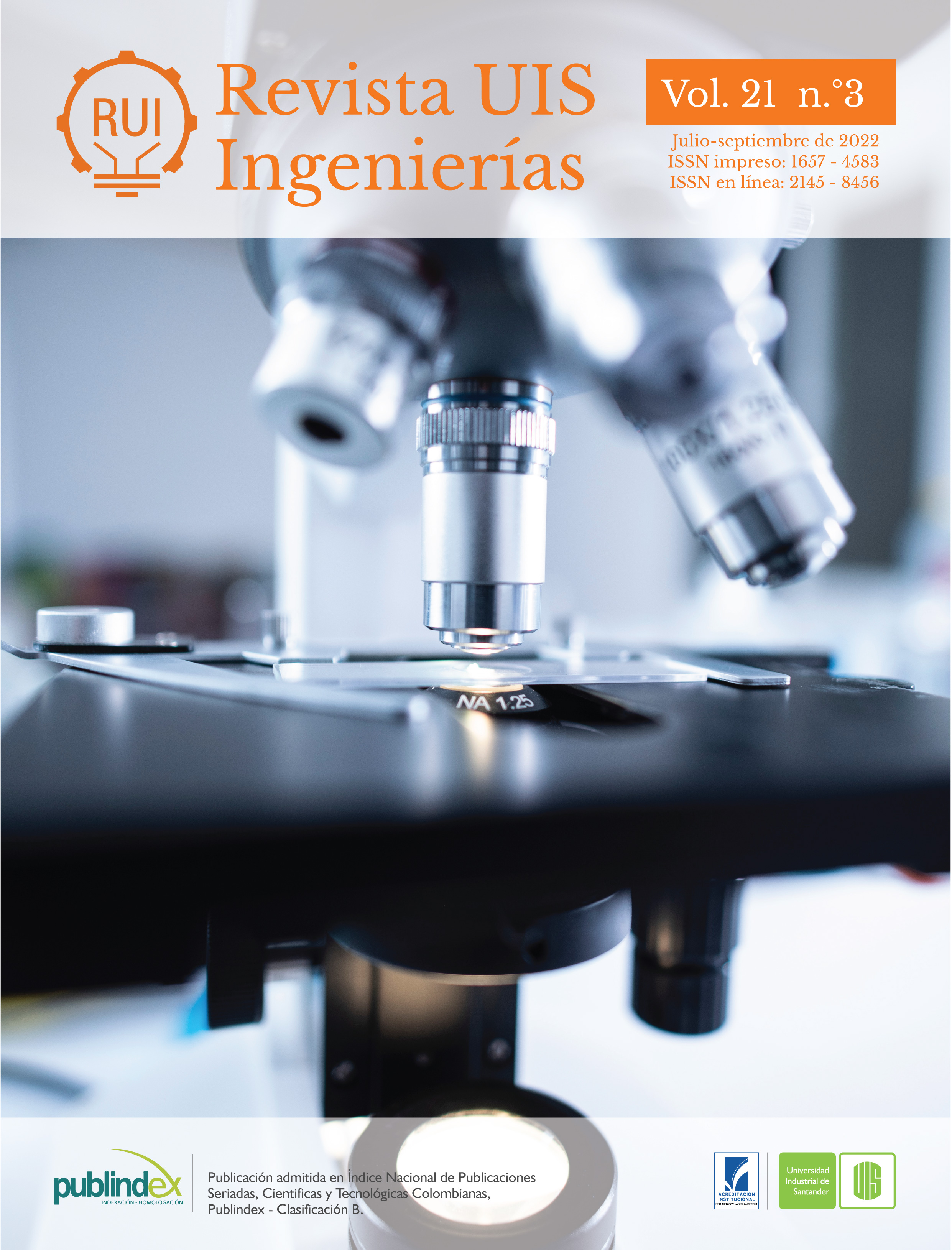Síntesis y caracterización de láminas de grafeno a partir de polvo de grafito mediante molienda de bolas
Publicado 2022-07-12
Palabras clave
- grafeno,
- grafito,
- molienda de bolas,
- síntesis,
- caracterización
Cómo citar
Derechos de autor 2022 Revista UIS Ingenierías

Esta obra está bajo una licencia internacional Creative Commons Atribución-SinDerivadas 4.0.
Resumen
Debido a la tendencia al alza en el material bidimensional, el grafeno ha ganado mucho interés en el pasado reciente. El grafeno es el alótropo de carbono 2D con propiedades mecánicas, químicas y eléctricas mejoradas de alta resistencia. A pesar de tener excelentes propiedades entre otros tipos de alótropos de carbono, el uso del grafeno es limitado debido a su costosa técnica de síntesis. En esta investigación se adapta un método económico y efectivo para la preparación de grafeno a partir de polvo de grafito. El polvo de grafito se trata térmicamente para preparar el grafito exfoliado y luego se muele para producir las láminas de grafeno 2D. El grafeno sintetizado se caracteriza por difractometría de rayos X (XRD) y microscopio electrónico de barrido (SEM). Los resultados de XRD muestran que el grafeno se sintetiza con éxito y los resultados de SEM muestran que el grafeno es 2D que se puede usar en varias aplicaciones. Esta investigación proporciona una dirección para la síntesis de grafeno a partir de polvo de grafito a escala industrial.
Descargas
Referencias
- K. S. Novoselova. K. Geims. V. Morozovd. Jiangy. Zhangs. V. Dubonosi. V. Grigorievaand A. A. Firsov, “Electric Field Effect in Atomically Thin Carbon Films,” Science, vol. 306, no. 5696, pp. 666-669, 2004, doi: https://doi.org/10.1126/science.1102896
- K. I. Bolotin et al., “Ultrahigh electron mobility in suspended graphene,” Solid State Communications, pp. vol. 146, pp. 351–355, 2008, doi: https://doi.org/10.1016/j.ssc.2008.02.024
- L. Banszerus et al., “Ultrahigh-mobility graphene devices from chemical vapor deposition on reusable copper,” Science Advances, vol. 1 no. 6, 2015, doi: https://doi.org/10.1126/sciadv.1500222
- A. A. Balandin et al., “Superior Thermal Conductivity of Single-Layer Graphene 2008,” Nano Lett., vol. 8, no. 3, pp. 902–907, 2008, doi: https://doi.org/10.1021/nl0731872
- D. L. Nika, A. A. Balandin, “Phonons and thermal transport in graphene and graphene-based materials,” IOP SCIENCE, vol. 036502, 2017, doi: https://doi.org/10.1088/1361-6633/80/3/036502
- A. A. Balandin, “Phononics of Graphene and Related Materials”, ACS NANO, vol. 14. no. 5, pp. 5170-5178, 2020, doi: https://doi.org/10.1021/acsnano.0c02718
- M. J. Allen, V. C. Tung, R. B. Kaner, “Honeycomb Carbon: A Review of Graphene,” Chem. Rev. vol. 110, no. 1, pp. 132–145, 2010, doi: https://doi.org/10.1021/cr900070d
- C. Lee, “Measurement of the Elastic Properties and Intrinsic Strength of Monolayer Graphene,” SCIENCE, vol. 385, no. 2008, 2012, doi: https://doi.org/10.1126/science.1157996
- F. Bonaccorso, Z. Sun, T. Hasan, and A. C. Ferrari, “Graphene photonics and optoelectronics,” Nature Photonics, vol. 4, pp. 611–622, 2010, doi: https://doi.org/10.1038/nphoton.2010.186
- T. Han et al., “Extremely efficient flexible organic light-emitting diodes with modified graphene anode,” Nature Photonics, vol. 6, pp. 105–110, 2012, doi: https://doi.org/10.1038/nphoton.2011.318
- B. Kulyk et al., “A critical review on the production and application of graphene and graphene-based materials in anti-corrosion coatings,” Crit. Rev. Solid State Mater. Sci., vol. 47, no. 3, pp. 309–355, 2021, doi: https://doi.org/10.1080/10408436.2021.1886046
- J. Y. Lim, N. M. Mubarak, E. C. Abdullah, S. Nizamuddin, M. Khalid, Inamuddin, “Recent trends in the synthesis of graphene and graphene oxide based nanomaterials for removal of heavy metals — A review,” J. Ind. Eng. Chem., vol. 66, pp. 29–44, 2018, doi: https://doi.org/10.1016/j.jiec.2018.05.028
- S. Alam, B. Nizam, U. Maksudul, “Synthesis of graphene,” Int. Nano Lett., vol. 6, pp. 65-83, 2016, doi: https://doi.org/10.1007/s40089-015-0176-1
- N. Kumar et al., “Top-down synthesis of graphene: A comprehensive review,” FlatChem, vol. 27, 2021, doi: https://doi.org/10.1016/j.flatc.2021.100224
- D. Pe, D. Pen, I. Pozo, E. Guitia, “Synthesis of Nanographenes, Starphenes, and Sterically Congested Polyarenes by Aryne Cyclotrimerization,” Acc. Chem. Res., vol. 52, no. 9, pp 2472-2481, 2019, doi: https://doi.org/10.1021/acs.accounts.9b00269
- L. Hlekelele, P. J. Franklyn, K. Tripathi, S. H. Durbach, “Morphological and crystallinity differences in nitrogen-doped carbon nanotubes grown by chemical vapour deposition decomposition of melamine over coal fly ash” RSC Adv., 2016, doi: https://doi.org/10.1039/C6RA16858B
- R. Ye, D. K. James, J. M. Tour, “Laser-Induced Graphene,” Acc Chem Res. Vo. 51, no. 7, pp 1609-1620, 2018, doi: https://doi.org/10.1021/acs.accounts.8b00084
- H. C. Schniepp et al., “Functionalized Single Graphene Sheets Derived from Splitting Graphite Oxide,” J. Phys. Chem. B, vol. 2, pp. 8535–8539, 2006, doi: https://doi.org/10.1021/jp060936f
- N. Antonatos, H. Ghodrati, “Elements beyond graphene: Current state and perspectives of elemental monolayer deposition by bottom-up approach,” Applied Materials Today, vol. 18, 2020, doi: https://doi.org/10.1016/j.apmt.2019.100502
- A. G. Olabi, M. A. Abdelkareem, T. Wilberforce, E. T. Sayed, “Application of graphene in energy storage device – A review,” Renew. Sustain. Energy Rev., vol. 135, 2021, doi: https://doi.org/10.1016/j.rser.2020.110026
- A. S. Nair, V. Nallusamy, K. Jayasankar, S. Ss, “Scalable preparation of graphene from graphite ore via mechano-chemical ball milling,” Mater. Manuf. Process., vol. 37, no. 1, pp. 113–122, 2022, doi: https://doi.org/10.1080/10426914.2021.1945094
- M. A. Saiful Badri, M. M. Salleh, N. F. ain Md Noor, M. Y. A. Rahman, A. A. Umar, “Green synthesis of few-layered graphene from aqueous processed graphite exfoliation for graphene thin film preparation,” Mater. Chem. Phys., vol. 193, pp. 212–219, 2017, doi: https://doi.org/10.1016/j.matchemphys.2017.02.029
- A. A. Naqvi, A. Zahoor, A. A. Shaikh, F. A. Butt, F. Raza, I. U. Ahad, “Aprotic lithium air batteries with oxygen-selective membranes,” Mater. Renew. Sustain. Energy, vol. 11, pp. 33-46, 2022, doi: https://doi.org/10.1007/s40243-021-00205-w

